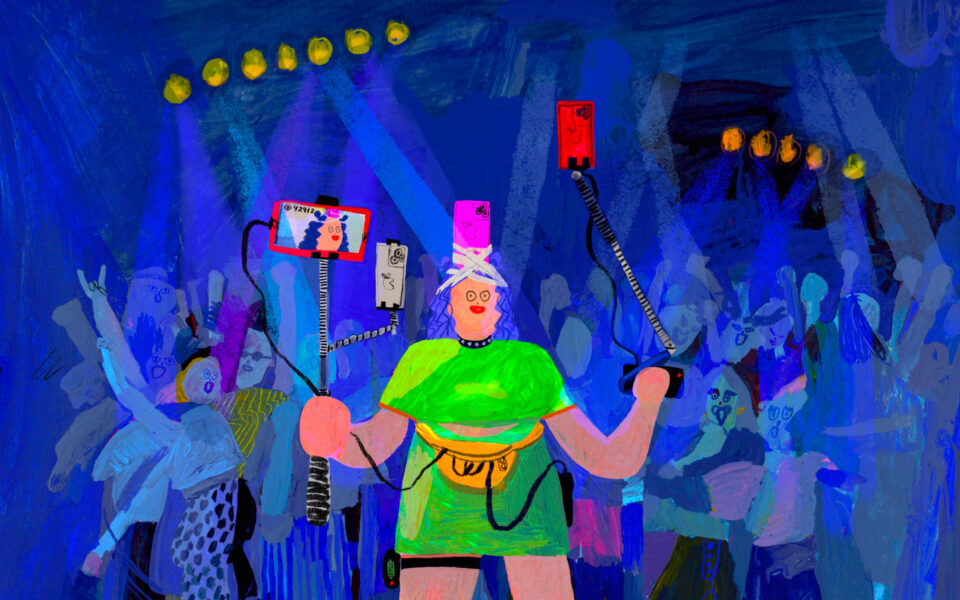Can’t make the concert? Livestreamers are coming to the rescue

Live music tentatively returned in 2021 after Covid shutdowns. More artists got back on the road in 2022, yet still hit pandemic-related snags. But 2023 has been a blockbuster for the live-music business: Taylor Swift and Beyoncé circled the globe with headline-grabbing extravaganzas, and they weren’t the only story. Bruce Springsteen, Metallica, Drake, Travis Scott, Ed Sheeran, Morgan Wallen, Maluma and Madonna filled arenas and stadiums.
Buying concert tickets, however, has become an increasingly complex and expensive endeavor as costs continue to rise and companies such as Ticketmaster and SeatGeek battle bots and scalpers. Fans hoping to attend the year’s hottest tours endured a maze of presale registrations, digital waiting rooms and hourslong queues. Those fortunate enough to reach checkout were met with lofty ticket prices – some because of confusing “dynamic pricing” – and additional fees.
But listeners left at home weren’t totally left out: iPhones, Instagram and TikTok have opened the door for intermediaries to bridge the gap between the gig and fans who didn’t have the money, connections or luck to get through the gate.
While in 2020, many artists turned to professional livestreaming through official channels to beam shows to fans stuck in their homes, the format was largely abandoned as in-person concerts returned. Three years later, a different kind of livestreamer has come to the fore: amateur camerapersons who show up with phones taped to their heads and backup batteries at the ready, eager to help hundreds – or hundreds of thousands – view the concert from home.
The increasing sophistication of phone cameras, the popularity of platforms with live capabilities and the challenging process of securing tickets to big shows have all but codified livestreams as an extension of today’s live music experience. “With the rising prices and Ticketmaster fiasco we weren’t able to get tickets,” said Kelly Epstein, a Taylor Swift fan who has (virtually) attended nearly every weekend of the Eras Tour with her two young daughters. “Livestreams allow us to feel like we are going to the show.”
In the days before sharing a concert live was technologically feasible, tape traders lugged equipment to shows where recording was permitted – frequently by jam bands, including the Grateful Dead and Phish, who viewed the recordings circulating among superfans as a harmless noncommercial means of expanding their reach. Tape traders approached their hobby with the seriousness of professional archivists: collecting hundreds of cassettes, often identifiable by carefully handwritten titles and set lists, and safeguarding memories and music for generations.
So who is a livestreamer today? Some spend a few casual minutes with their phones trained on the show, giving at-home viewers a taste that could leave them more frustrated than pleased. But others increasingly treat their role with the seriousness of a live correspondent. Meet Matthew Serafin, a global traveler catering to a rabid fan base while becoming a character himself; Morgan Lee, a spontaneous streamer who rescued an important concert from obscurity; and Tess Bohne, an at-home aggregator dedicated to Swifties.
The road warrior
Matthew Serafin was supposed to be heading home on an international flight, but he was too jazzed up to go to the airport.
The night before, Serafin, 28, from Chicago, had livestreamed the opening of Beyoncé’s Renaissance World Tour in Stockholm. Serafin had gone live once before – for a portion of a 2022 Adele concert in Las Vegas, when less than a dozen people had joined his stream. Expecting the same results in Stockholm in May, he watched in amazement as Lizzo, SZA and tens of thousands of other viewers tuned in.
Beyoncé would grace the stage for a second night in less than 12 hours. “I had to stay,” Serafin recalled in an interview. He was lucky enough to grab a ticket to the show on Ticketmaster and booked one of the few remaining hotel rooms in a city experiencing a Beyoncé-related travel boom.
Serafin was hooked. Hooked on Beyoncé (“My queen forever,” he said) and hooked on being the conduit between the artist he loved most and the rest of the world. “My Instagram was flooded with messages from people thanking me for sharing the show. People from Sudan, Kenya, Norway, Peru – places that Beyoncé has never and probably will never tour,” he said.
Since the Stockholm show, Serafin has attended eight Renaissance World Tour shows, and two of Swift’s Eras Tour shows across four countries – livestreaming each performance.
“To me, live music is, like, everything,” he said. Growing up, he was among the few openly gay students at his high school in the Chicago area. At Beyoncé and Lady Gaga concerts, he said, he learned to express himself among a queer-positive crowd.
Serafin estimated he’d spent $7,000 to $8,000 on his global livestreaming tour – a sum he could muster thanks to his salary as an associate in the commercial bank at JPMorgan Chase “and a bit of fiscal irresponsibility.” Sharing his experience with others was worth the cost: “Every individual on my stream is someone who’s touched by getting to experience the show and wasn’t able to be there themselves.”
And he enjoys the recognition that comes with being a vital streamer. “I just go to work and I am just like a dude in khakis,” Serafin said. But at Beyoncé concerts, he’s something of a star. “People stop me. People ask for photos. It’s crazy.”
As his audience has grown on Instagram, so has his ambition to move beyond megastars. Recently, he’s begun streaming shows of pop up-and-comers like Muna and Reneé Rapp. “I want to introduce people to folks they may not know,” he said.
The one-time savior
Morgan Lee had been standing in the hot desert sun for 12 hours to secure a near-perfect view of Frank Ocean’s 2023 headlining performance at Coachella – a performance she was starting to fear wouldn’t even happen.
The artist was an hour late, and YouTube had canceled its livestream of the set – the only viewing option for fans unable to afford the festival’s $549 tickets (fees not included). When, finally, Ocean stepped onto the stage, Lee, 18 and from North Carolina, pulled out her phone. “I knew people would want to see this,” she said.
By the night’s end, hundreds of thousands of people had hopped onto Lee’s livestream – at its peak, 125,000 people were on simultaneously. Her Instagram account grew from 6,000 to 60,000 followers, her name trended on Twitter and Lee was crowned a hero by fans across the internet.
The viral moment changed her life: In June, she leveraged her newfound social media audience to release a debut music video and, a few weeks later, she was taken off the wait-list at New York University’s Clive Davis Institute of Recorded Music (“the closest thing one could get to going to pop star school,” she said).
Lee, who is now in her first year at NYU, described the event as a happy accident. Still, her prime view of the Coachella stage at the Ocean concert, which helped popularize her stream over others, was more a product of her devotion to the artist she loves than luck. Since she was a young teen, Lee has been concert camping – waiting for hours, or days, to get as close to the stage as possible.
In August, she woke up at 3 a.m. to attend the Renaissance World Tour – her first-ever Beyoncé concert. As with Ocean’s set, she was breathlessly close to the star. But, this time, Lee didn’t go live. “I don’t want to be boxed in as a streamer,” she said, “My goal is to be an artist.”
Even if she won’t livestream again, she’s happy she could provide the show to fans at home. “It’s not like an accessible show,” she said. “Streaming is the next best thing.”
The at-home director
Tess Bohne, 32, has spent the past few months helping Swifties, one of the most voracious fan bases in the world, gain nightly access to Eras Tour concerts that she locates, curates and blasts out to her followers.
Unlike Serafin and Lee, Bohne doesn’t film the concerts herself. She earned the unofficial title “livestream queen” of the Eras Tour by using multiple devices to scan social media to find the best streams occurring at any given time.
When presale tickets for the tour became available last November, Bohne knew she was among the lucky ones: she snagged two tickets to the second night of the Eras Tour stop in Glendale, Arizona. After watching the show live, Bohne resolved to provide “the Eras Tour for everyone.”
The result was a DIY streaming command center set up in Bohne’s bedroom in Salt Lake City, equipped with a computer, two monitors, two iPads and a ring light. For 39 Eras Tour shows (and counting), the 32-year-old has planted herself there, finding the highest quality livestream running and re-streaming it from her iPad to her hundreds of thousands of TikTok followers. In the background, she has anywhere from one to four backups ready if a stream cuts out.
“For me, doing these livestreams has felt like a stick it to the man,” she said. “It’s a way of saying, you screwed us over but it’s not stopping us.” As a stay-at-home-parent to three young children, she said streaming has also given her “purpose outside of motherhood.”
Watching Bohne’s stream is dizzying. Texts and emojis whiz by as fans communicate on the chat function – feeding off each other’s energy like at live shows. “It’s their way of being at the concert with their friends,” Bohne said.
Her stream is an act of love – and labor (she makes her Venmo handle available for tips). The job hasn’t been lucrative, but she’s making enough to cover her expenses and, at least for now, justify the over 200 hours spent livestreaming the Eras Tour.
This article originally appeared in The New York Times.






